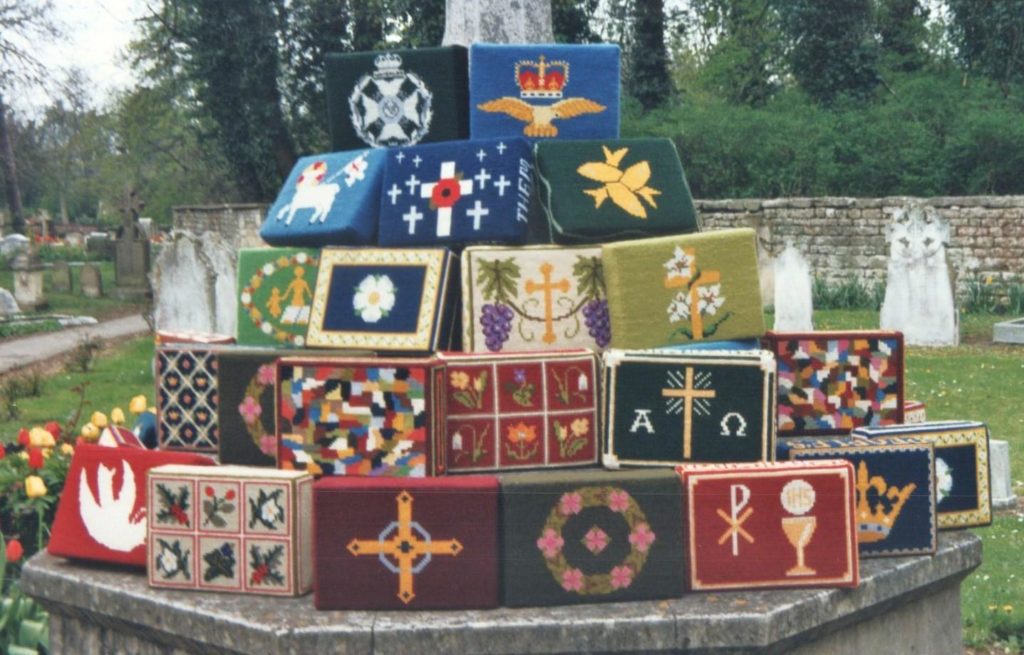
We have 130 kneelers, plus a two-person kneeler for weddings, plus the maroon and gold tapestry kneelers at the communion rail. These were all stitched by members of the congregation – mostly by four members of the congregation though many others produced one or two. The kits, which cost £16.80 at the time, were given to Holy Trinity by several people. Turn over the kneelers and have a look. The labels stuck onto the hessian on the underside give the name of the needlewoman (and one prolific needleman), the donor, and the dedication. The Indian ink has faded in the 22 years since most of the work was done and many of the ladies who stitched these bright and beautiful objects have died, but the faces of long-time locals still light up at the mention of a name.
Strictly speaking, a kneeler is called a hassock. Kneelers are people who kneel. But since congregations have largely given up kneeling these days the Old English ‘hassock’ has given way to the easier word.
In the 1960s the Holy Trinity faithful were kneeling on what the December 1950 issue of the magazine dubbed our ‘disintegrating hassocks’. There are still one or two of them around: ‘horrible red things’, says Pam Weston, on which everyone was ‘slipping and sliding’. They were in such a state by late 1962 that Mrs Clifford and the members of the Mothers Union worked hard and long to clean and recover them. “There have been many sore and bleeding fingers of the course of this labour,” records the magazine in October 1962, which also commemorates Mr Clifford’s work fitting the pews with hooks from which to hang the hassocks, ‘an operation which greatly facilitates the cleaning of the building and the preservation of the kneelers’.
The slippery red pads lasted another 30 years before Fr Head suggested new kneelers. The members of the Mothers Union, 30 years older by now, swung into action. ‘Calling all embroiderers’ said the magazine in October 1990. Margery Clifford again did the organising. Only eighteen months later, the work was done.
Pam and Jim Weston are responsible for stitching 20 kneelers each, says Pam (and probably rather more, if you do a count). Another inexhaustible worker was Jean Snowden. Their techniques were very different. Some churches had stitching parties. In HT, people did their work in their own time. Using 5 holes per cross-stitch, Pam and Jim would take about one week per kneeler, after which Jim (who was apparently ‘much neater’ than Pam and had stronger fingers), stitched up all their canvases (and those of several others) onto the hessian undersides and secured the high density foam pads inside. ‘I’d never done tapestry before,’ says Pam. The pair would sit stitching together. ‘It was stitching or Scrabble,’ and became so hooked that they took kits with them when they went away, so there is at least one kneeler somewhere that has travelled in embryo stage to Australia and back. One website about kneelers suggests 32 hours work per cushion.
Jean Snowden ‘would pick it up and put it down. There was always something on the way. You’d do a little between washing the dishes. I carried on in my own sweet way. It was easier to do in daylight: the colours don’t show so well otherwise.’ Margery Clifford was the fourth prolific worker. Everyone’s work was blessed on Sunday 21 April 1991. In 1998, the altar kneelers, which use the three intersecting circles of the Holy Trinity (a design chosen by the vicar Tom Honey), were completed and stretched over three inch padding onto their wooden frames by local upholsterer Mr Gomersall and blessed by Tom Honey. Yes, Pam and Jim Weston worked these too, together with Jean Snowdon, Marta Sykes (who had helped with the altar tapestry), and Margaret Clarke, one of the Mothers Union’s most efficient organisers. These names are HT’s roll of honour.
‘Please use them as kneelers and not footstools,’ urges the magazine in January 1994; ‘in summer, shoes are dusty but in winter they are muddy as well and hours of loving work can be ruined so easily.’ In 2015, another party of sewers added loops to the kneelers so that they could hang from Mr Clifford’s hooks, so the footstool danger is now past.
The designs and kits were supplied by Jacksons of Hebden Bridge, who are still very much in business and whose website catalogues almost all the designs that have become so familiar to us. Jacksons also designed the special commissions: the Mothers Union initials, the Quarry Men’s Morris Dancers crest, gurkha daggers and regimental shields of importance to the givers. Almost all the kneelers have a story stitched into them, like the summer scene chosen by Jean Berryman to commemorate the Berrymans’ summer marriage years earlier.
‘Church needleworkers say that each individual kneeler is an act of worship in and of itself,’ writes Jean Terepka online, an expert on kneelers. ‘Every newly dedicated kneeler is a cause for rejoicing. Any church, large or small, graced with an array of beautiful, colourful and meaningful kneelers is a church whose parishioners and visitors alike will feel admiration, awe and delight.’
Jemima Kallas
Thank you to Pam Weston, and to Jean Snowden and her children Joan and Stephen Jones
